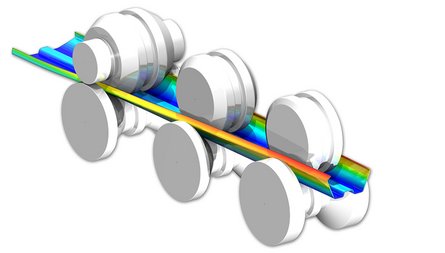
What is roll forming?
Roll forming, also spelled rollforming, is a type of rolling involving the continuous bending of a long strip of sheet metal (typically coiled steel) into a desired cross-section. The strip passed through sets of rolls mounted on consecutive stands, each set performing only an incremental part of the bend, until the desired cross-section (profile) is obtained. Roll forming is ideal for producing constant-profile parts with long lengths and in large quantities.
Cold sections are produced from flat-rolled primary material in a cold process - thus well below the recrystallisation temperature. The profiles are usually characterised by a practically constant wall thickness in all cross-sectional areas. The uncommonly diverse cross-sectional design and the high output capacity have given the cold rolled section a foothold in virtually all branches of industry. Cold rolled sections (also called "cold rolled sections" or "light steel sections") are produced not only by forming on profile rolling machines but also on press brakes and folding machines. Both open and closed profiles are produced on roll forming lines. In the case of closed cross sections, an additional joining process is required - usually a welding process or a so-called "seam closure". One of the many applications of this highly productive process is the manufacturing of longitudinally welded tubes.
Listed below are some of the many advantages of roll forming:
- The virtually unlimited design possibilities for profile cross sections.
- A favourable ratio of section modulus to profile weight (high load capacity).
- Excellent for integrating pre- and post operating steps such as punching, perforating, deep-drawing or roll bending ("sweeping" and "curving"). Processes such as welding or cross section measurements can also be easily integrated with the system.
- The usability of different materials (steel, non-ferrous metals) with different surfaces - up to coated sheets.
- The process can manufacture almost all sheet metal thicknesses - from 0.1 mm to 20 mm and more).
- There are no theoretical limits to the required profile dimensions or maximum profile lengths.
- Constant product quality, minimal material handling, cost-effective rolls with long tool life, achievable strict tolerances.
- Simple operation of the systems and consistent planning of new products with the help of COPRA software products by data M.

